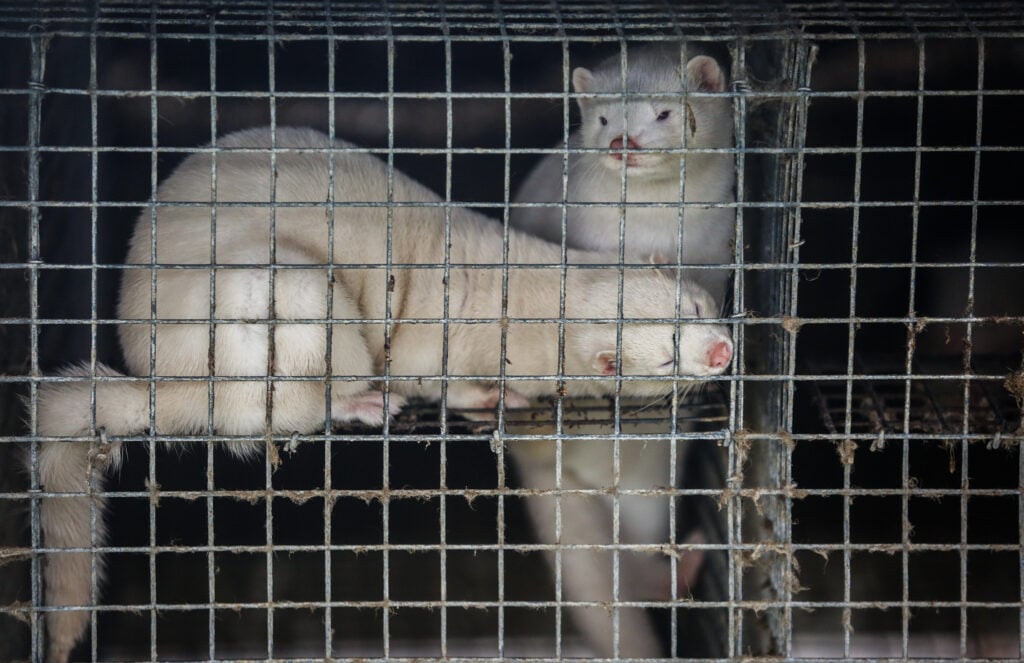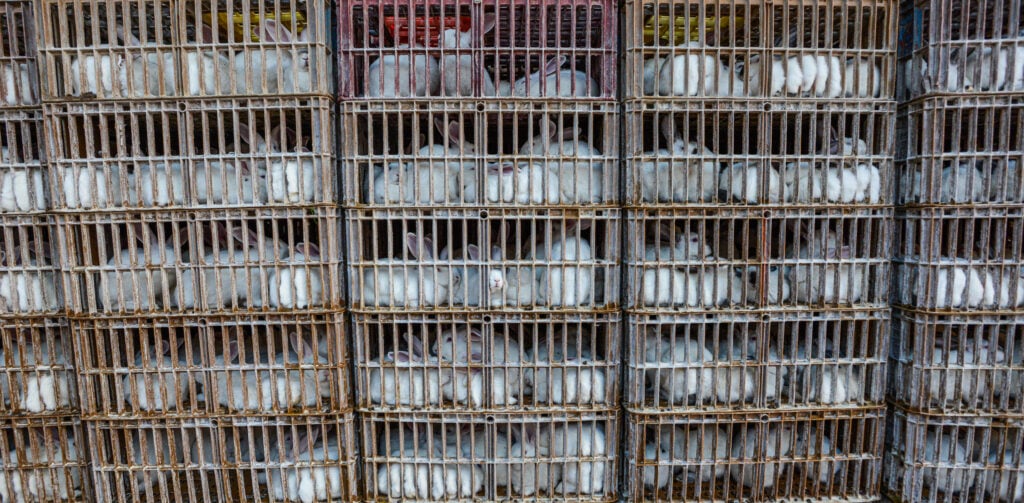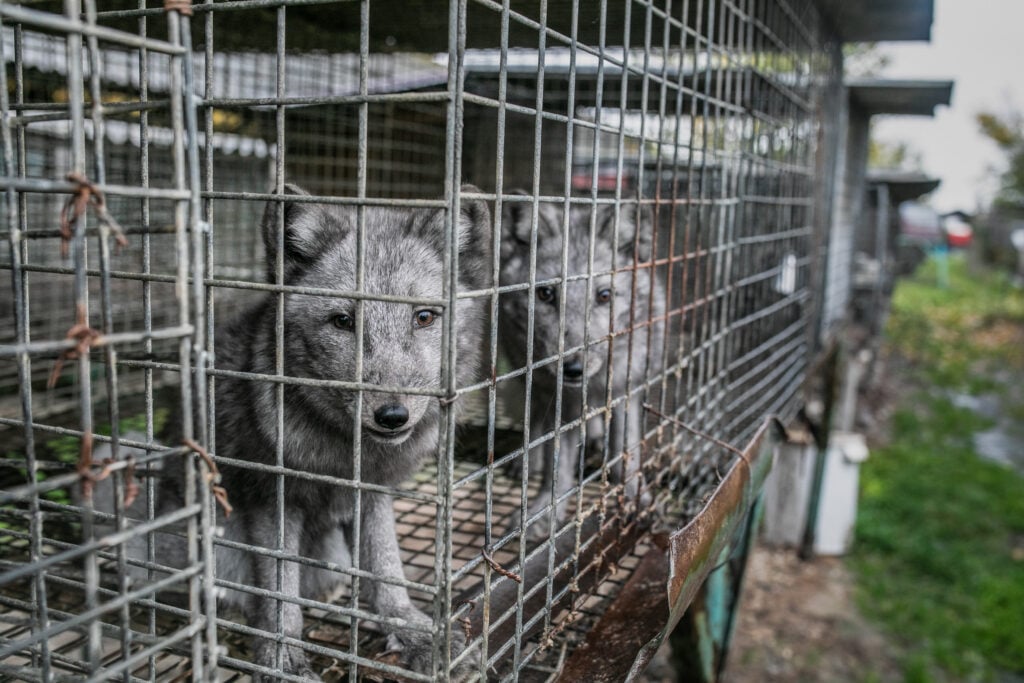Over the last few decades, the fur industry has come under a significant and increasing level of scrutiny. Concerns around ethics, animal welfare and cruelty, as well as sustainability, are at the center of the backlash towards fur farming.
Humans have been wearing the fur and skins of animals for thousands of years. But industrial animal farming for this purpose is a relatively modern – and hugely controversial – concept.
It was during the late 20th century that the ethical costs of fur farming entered mainstream public consciousness. Following campaigns by animal welfare groups such as PETA, as well as a growing number of celebrities swearing against it, many people now refuse to wear fur on moral grounds. The material is contentious across the globe, and fur farming is illegal in countries including the UK, Austria, Italy, and Croatia.
In response to the growing notoriety of its products, the fur industry has in recent years begun to market itself as “ethical” and “sustainable.” The validity of such claims, though, has been questioned.
Plant Based News sat down with Dr Clair Linzey, deputy director of the Oxford Centre for Animal Ethics and author of An Ethical Critique of Fur Factory Farming, to discuss the industry as a whole. In addition, its dubious attempts to reconcile itself with the public.

How many animals are killed for fur?
It’s thought that around 100 million animals are farmed for fur each year. This figure is a rough estimate, as data on fur farms is limited and varies by country. Countries that produce and export fur include the USA, China, Finland, Russia, Denmark, and Poland.
The reason that the number of animals killed for fur is so difficult to measure, Dr Linzey says, is because of differing rules in each country on how to count them. In China, which is one of the world’s biggest fur exporters, fur farms are under no obligation to count the animals they kill at all.
In other countries, such as the USA, the number of animals are measured by the “pelts” that they produce. As some animals produce pelts that are unusable, Dr Linzey says that there are a “huge number” who go unaccounted for. “America just counts the number of pelts produced, not the number of animals killed,” she says. “So it’s actually very difficult to quantify the suffering.”
How are animals kept and killed on fur farms?
The two most popular animals raised for fur are foxes and mink. But rabbits, chinchillas, and raccoon dogs are also regularly used in the industry. The vast majority of these animals are kept in unnatural and cramped conditions. Many will spend their lives in small wire cages, which are often stacked on top of each other.

“Foxes normally travel a huge amount of territory, and they are confined and forced into very close proximity with other animals,” Dr Linzey says. “And if you’re a mink who is primarily a solitary animal, this is very, very difficult for them. Also mink are primarily water animals, and so actually having access to water is one of their basic needs that just isn’t being met.”
The animals often suffer from disease, and many show symptoms of extreme mental distress. “There are mental health disorders that those animals exhibit, which they wouldn’t exhibit living their natural life, like biting or biting or running in circles,” Dr Linzey says. “It’s hard to quantify exactly how bad the conditions are because it’s on a scale that’s hard to imagine.”
Animals are typically kept for six to nine months before being killed. During this time, they are often overfed to maximize the size of their pelts. The most common methods of slaughter are electrocution via the anus or gassing. Some animals may also have their necks broken, be clubbed to death, or even skinned alive.
Can fur be ethical? What is WelFur?
In response to growing awareness of animal cruelty in the industry, some fur products are now marketed as “ethical.”
WelFur is a certification program that was set up by the European Fur Breeders’ Association (EFBA) in 2009. It supposedly promotes animal welfare and transparency on farms relating to animals’ housing, behavior, feeding, and health. Fur brands can therefore be certified by WelFur if they live up to its standards. The plausibility of the program, however, is unverified.
According to Dr Linzey, the system is unregulated and promoted by the fur industry itself. The level of animal “welfare” that it requires farms to adhere to is also low and arguably insufficient.

“When we looked at the standards that they imposed to regulate what was considered good animal welfare within the fur industry, they included things like bent feet, ocular discharge, chewing off tails,” she says. “And we really started asking ourselves, if WelFur is really a good standard of welfare for the animals involved, then why are there any injuries at all? Why are these animals regularly experiencing severe injuries?”
Rather than a viable assurance program, Dr Linzey describes WelFur as an attempt by the fur industry to “make the consumer feel more happy about buying fur.”
Is fur really sustainable?
The environmental costs of fashion are increasingly coming under the spotlight. It’s thought that the industry as a whole is responsible for around 10 percent of carbon emissions. It’s also a leading cause of waste and pollution.
Much of the controversy surrounding fashion involves its use of synthetic materials. These are often made of plastics and tend to be non-biodegradable, energy intensive, and full of chemicals. Animal fur, which at first glance is an all-natural material, is often marketed as an eco-friendly alternative to these.
“Natural fur is a sustainable fashion material which can be absorbed back into nature’s own cycle through biodegradation,” reads a website owned by Fur Europe. “A renewable resource with outstanding thermal qualities, natural fur also has much less impact on landfills and oceans than synthetic alternatives, which are made from plastics.”
The environmental credentials of real fur, however, have been debated. While it’s true that the fur naturally growing on animals is sustainable, it’s the processing of fur as it is made into fabric and clothing that is a point of concern.
“Given the tanning processes that fur has to go through to become fur it’s really just greenwashing,” Dr Linzey says. “A huge amount of toxins and pollutants are released into the environment from the process of getting fur ready to be fit for human consumption.”
Ecopel, an apparel manufacturer specializing in faux fur, echoes this. On its website, the company points to research claiming that four times more energy is needed to produce a “real” fur coat, compared to a faux fur one. Further, creating a mink fur coat emits seven times more CO2 than a vegan fur coat, it says.

Fur farming and pandemic risk
The fur farming industry came under renewed scrutiny during the coronavirus pandemic over fears of its ability to spread disease. “Fur farming got a very bad press under the pandemic because fur farms became incubators of Covid-19,” says Dr Linzey. “That’s one of the other problems about intensively rearing any animals.”
Since April 2020, Covid-19 has impacted more than 450 mink fur farms in Europe and America. This has led to millions of animals being culled. The first outbreak was detected in April 2020 in the Netherlands. The illness has since been recorded on farms in Denmark, Greece, Canada, Poland, Spain, and the USA.
The unhygienic and cramped conditions at mink farms create perfect breeding grounds for disease. Covid-19 can jump back and forth between mink and human farm workers. Experts say this could allow the virus to mutate in the non-human animals before affecting humans.
In a 2020 report, the European Centre for Disease Prevention and Control (ECDC) stated: “the continued transmission of SARS-CoV-2 in mink farms may eventually give rise to other variants of concern.”
Bird flu
But Covid-19 is just the start of fur’s impact on public health. In October 2022, it was found that mink at a farm in Galicia, northwestern Spain, had contracted avian flu. The discovery came amid what’s thought to be the worst outbreak of the disease of all time. It’s believed that the virus mutated to allow the minks to transmit it between each other.
“Now it looks like it can spread between mammals, and this is something we don’t want to see,” Professor Koopmans, who was a member of the World Health Organization (WHO) team tasked with tracing the origins of Covid, said at the time. “This means there is an opportunity for a virus from the risk list to pick up mutations which could make it transmissible between humans.”
The future of fur
Despite its ethical and environmental costs, fur continues to be popular and publicly accepted in many places. In particular, throughout Canada and eastern Europe, including Russia.
While it’s true that some countries have banned fur farming, they still continue to import millions of dollars worth each year. In the UK, for example, there is an ongoing campaign to ban such imports, something that the government has failed to deliver despite promising to do in 2021.
But it’s not all bad news. Despite the industry’s attempts at greenwashing and “humane” labels, fur is falling out of favor across much of the world. In January 2023, California became the first US state to ban the sale of all new animal fur products both online and in stores, over ethical concerns. Many fashion companies – including Gucci, Prada, Burberry, Chanel, Dolce & Gabbana, and Michael Kors – have also made commitments to remove animal fur from their collections.
A number of cities have moved away from fur during their fashion weeks, too. This includes London, Helsinki, and Copenhagen. Meanwhile, high-profile designers, like Stella McCartney, are creating luxury items made of faux vegan fur.
“There is a movement against fur, but we’re still talking about a multimillion pound industry. And so there are a lot of vested interests in keeping it,” says Dr Linzey. “I think it’s one of those areas in which consumers can be really active. Using their money to buy products that they know are cruelty-free is crucially important to change.”
—
If you purchase something through a link on our site, Plant Based News may earn a commission. This helps us to provide our free services to millions of people each week.






